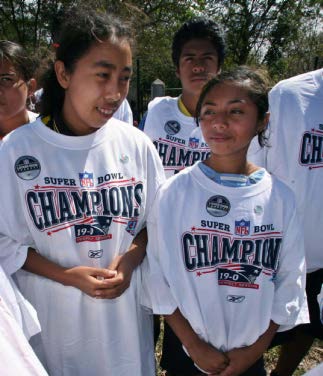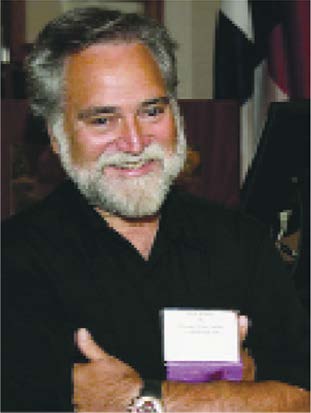ANCORA IMPARO
RICK RADER, MD ■ EDITOR-IN-CHIEF

LOSING YOUR SHIRT: Students in Nicaragua wearing T-shirts celebrating the 2007 New England Patriot's undefeated 19-0 season and Super Bowl XLII victory. The New York Giants beat the Patriots 17-14 in that game.
How "Losers" from America are Exported
Unlike the NFL T-shirts of "losing teams," there are no losers in the Special Olympics. The Special Olympics T-shirts have no equivalent of the NFL teams that went home defeated and without a single championship T-shirt
The 54th National Unlike the NFL T-shirts of "losing teams," there are no losers in the Special Olympics. The Special Olympics T-shirts have no equivalent of the NFL teams that went home defeated and without a single championship T-shirt EST. Of course there was League (NFL) Championship, The Super Bowl, was a testimony to timing. This is not necessarily a tribute to the element of "timing" during game play. Surely timing is a vital part of the game and its tactics (the huddles are timed, the plays are timed, the time outs are timed, and delay of games are timed.) Timing was a major factor in the production of the Super Bowl. Everything about the game is rooted in "time." From the jet flyover, to the million-dollar commercials, to the half-time show, to the victory confetti splash, to dumping a keg of Gatorade over the winning coach; it gave the D-Day invasion a run for its money. Everything had to follow a strict and disciplined timeline with no room for errors. Even the potential for "over time" (if the game ends in a tie) is timed.
The Kansas City Chiefs (who had not been in a Super Bowl for 50 years) beat the San Francisco 49ers at exactly 10:11 pm EST. Of course there was chaos on the field with players hugging each other, holding up their children, and a stampede of reporters and photographers. At exactly 10:12 (one minute after the game) every member of the winning team was wearing a championship ball cap and T-shirt. Needless to say, this required both teams (winners and losers) to have previously designed, printed and delivered the T-shirts and ball caps weeks in advance.
According to sports writer Sam Richmond, "Rutgers and New Jersey (later known as Princeton) faced off in what is considered to be the first American football game ever played on November 6, 1869. The game took place in New Brunswick, New Jersey, with an audience of about 100 on hand, according to Rutgers. Rutgers won 6-4." None of the players or the fans wore T-shirts. There were none.
The earliest T-shirt dates back to 1898, at the Spanish-American War, when they were first issued as "undergarments" by the U.S. Navy. These were intended to be worn under a uniform and featured crew-necks, white cotton, and short sleeves. By the 1920s, "T-shirt" became part of American English and first appeared in the Merriam-Webster Dictionary. Writing in The White T, Alice Harris shares, "Printed T-shirts were in limited use by 1942 when an Air Corps Gunnery School T-shirt appeared on the cover of Life magazine. In the 1960s, print ed T-shirts gained popularity for self-expression as well for advertisements, protests, and souvenirs."
While the Kansas City Chiefs were parading around the field wearing their Championship T-shirts and hats, fans were lining up to purchase them. The day after the game, the internet was receiving tens of thousands of orders for printed merchandise. The printing companies were working overnight to prepare for the onslaught. One One thing you did not see was the San Francisco Super Bowl Championship T-shirts. In a ritual that resembled a black-ops assault, all the pre-printed San Francisco T-shirts and ball caps were locked away. They would never be available in the United States to fans, collectors, merchandisers, or thrift shops. Instead of hauling them off to landfills, a nonprofit organization, Good360, ships the "loser T-shirts" to countries across the globe, including Zambia, Bosnia, Romania, Armenia, Nicaragua, El Salvador, Mongolia, Uganda, Burundi, the Democratic Republic of Congo, Mali, and Rwanda. According to their chief development officer, Shari Rudolph, they take "every step possible to mitigate the risk of these items finding their way back into the US." Typically, the nonprofit distributes $330 million in goods each year. The NFL reports that over the years, they have donated over $9 billion dollars' worth of "loser's merchandise."
Pro football fans are not the only group that wear T-shirts to demonstrate their allegiance to and support for their teams and favorite players. Since the very first T-shirt printing business was established in 1948 (Tropix Togs specialized in creating T-shirts for Mickey Mouse, Davy Crockett, and the souvenir resort market), organizations involved in the disability rights movement have used the fronts and backs of T-shirts to announce their intentions to fight for rights, inclusion, and acceptance of individuals with intellectual and developmental disabilities and other complex disabilities. By all estimates, there are millions of T-shirts that have supported "runs, walks, concerts, marches, protests, clinics, golf tournaments and services, funding drives and advocacy movements" in over 100 languages. As an aside, I am at my computer wearing a T-shirt, a very special T-shirt. It's a Special Olympics T-shirt. And while you can see Special Olympics T-shirts in Zambia, El Salvador, Uganda, and Rwanda, they haven't been sent there by power house countries.
They were created, provided, and pro moted by the local Special Olympics programs in those countries – countries that believe in the Special Olympics. Unlike the NFL T-shirts of "losing teams," there are no losers in the Special Olympics. The Special Olympics T-shirts have no equivalent of the NFL teams that went home defeated and without a single championship T-shirt. Special Olympics T-shirts are cherished, often soiled, and always honored – just like the athletes who wear them.•

ANCORA IMPARO
In his 87th year, the artist Michelangelo (1475 -1564) is believed to have said "Ancora imparo" (I am still learning). Hence, the name for my monthly observations and comments. – Rick Rader, MD, Editor-in-Chief, EP Magazine Director, Morton J. Kent Habilitation Center Orange Grove Center, Chattanooga, TN